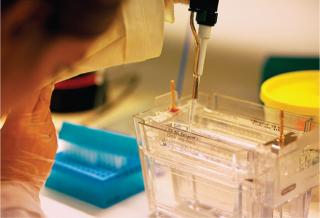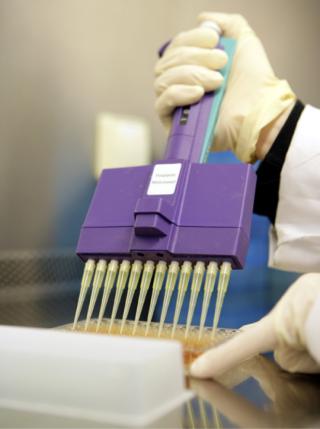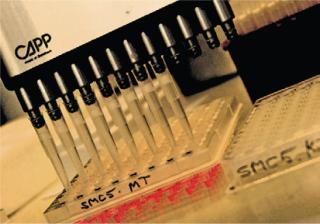Robots in the LaboratoryRobots in the Laboratory
November 1, 2013
Whether cell-based or molecular biology focused, most assays performed in biopharmaceutical laboratories involve liquid solutions. Increasingly, automated liquid handlers (laboratory robotics) are demonstrating utility in these labs, especially for high-throughput screening and optimization of cell culture media, chromatography conditions, formulations, and so on. Some experts say that screening 100,000 samples/day will soon become routine. But the robots haven’t condemned all manual pipettes to the trash heap — far from it.
With multichannel and electronic pipettes improving throughput and reproducibility of results, many companies don’t have to purchase expensive automated systems. From small-scale “automated pipetting technologies” to testing services such as Alphalyse that can perform assays you (or they) design, many alternatives are available.
Meanwhile, laboratory automation is putting robotics and software to work at expediting and increasing the efficiency and effectiveness of large laboratories. High-throughput screening, automated clinical and analytical testing, many biodiagnostic methods, and large-scale biorepositories would not be possible without advancements in laboratory automation.
A Brief History
Pipetting: Well-known 19th-century French scientist Louis Pasteur may be the pipette’s inventor, although a number of patents have been filed over the years — with early versions appearing in the United States about 100 years ago. Pasteur’s goal was to ensure that liquids could be removed from or transferred between vessels without introducing foreign contaminants. “Pasteur pipettes” were long, narrow glass tubes that helped him isolate pure cultures in his studies of infectious disease.

Laboratory Automation in the BPI Archives at www.bioprocessintl.com ()
Such glass pipettes contributed to many major biological discoveries throughout the 19th and 20th centuries. Some models used rubber bulbs to create suction and draw material in, then push it out again with a squeeze (like on a kitchen turkey baster). But amazingly, many scientists simply used their own mouths to do so (1). And getting sick from such work was a real danger. Now, carpal-tunnel syndrome and tendonitis are the most common safety issues associated with pipetting.
Plastics entered the picture in the 1940s. Disposable pipettes (and pipette tips) come in a number of designs and sizes for different applications, and they could be considered some of the earliest single-use technology to make inroads with the medical field. They are used mainly for aqueous solutions because organic solvents can dissolve plastic — as anyone evaluating single-use process components for leachables and extractables can attest. Because of the short contact time involved in transferring material from one place to another, however, leachables are not much of an issue in pipette use with acqueous samples.

Laboratory Automation in the BPI Archives at www.bioprocessintl.com ()
The first pipettes for microliter-scale transfer came from Eppendorf in the 1960s. The Gilson Pipetman model that came out in the 1970s enabled volume adjustment. Also in the 1970s, developers found ways to stop pipetted materials from being warmed by a user’s hand — a seemingly small change that could be a problem with some samples. Advances in the 1980s include replaceable tip assemblies and spring–leverage systems to reduce necessary thumb and tip-ejection pressures.
Modern adjustable pipettes use air-displacement technology to measure micro-, nano-, pico-, and even femtoliters of material. Fixed-volume types allow only an exact amount of liquid to enter a pipette, and positive-displacement designs for high-density liquids prevent air-cushion development. Air-displacement pipettes can be adjustable or fixed-volume; single-channel, multichannel, or repeater; standard or locking; manual or electronic; with conical or cylindrical tips.
Pipettes are ubiquitous in bioscience laboratories — from classrooms and academic research institutions to good laboratory practice (GLP) and good manufacturing practice (GMP) compliant drug quality departments. With such a large market, it’s no wonder that so many vendors supply pipettes and tips (including special filtered tips for in-pipette sample preparation): e.g., Artel, Bio-Rad Laboratories, Drummond, EMD Millipore, Eppendorf, Gilson, Greinor Bio One, Hamilton, Integra Biosciences, Perkin Elmer, Rainin, Sartorius Stedim Biotech, Sigma Aldrich, and Thermo Fisher, just to name a few.
Laboratory Automation in the BPI Archives at www.bioprocessintl.com
Lee CC, et al. High-Throughput Screening of Cell Lines Expressing Monoclonal Antibodies. BioProcess Int. May 4(5) 2006: 32–35.
Rosenfeld R, et al. High-Throughput Glycoanalysis for Biopharmaceutical Development and Manufacturing. BioProcess Int. BioProcess Int. 5(1) 2007: 38–47.
Venable D, et al. High-Throughput and Quantitative Detection of Residual NS0 and CHO Host Cell Genomic DNA. BioProcess Int. 5(6) 2007: 56–61.
McMillan G, et al. PAT Tools for Accelerated Process Development and Improvement. BioProcess Int. 6(3) 2008: S34–S42.
Carrier T. High-Throughput Process Development. BioProcess Int. 6(4) 2008: 54–58.
Rosin L. Cutting Down Process Time and Costs. BioProcess Int. 6(4) 2008: 70.
Wells G. In the Laboratory Automation Zone. BioProcess Int. 6(4) 2008: S56–S58.
Idusogie EE, et al. Development of an Antibody Screening Assay for Selection of Production Cell Lines. BioProcess Int. 6(4) 2008: 20–33.
Krishnamurthy R, et al. Emerging Analytical Technologies for Biotherapeutics Development. BioProcess Int. 6(5) 2008: 32–42.
Rosin LJ. Technologies and Training Move Sterility to New Levels. BioProcess Int. 6(10) 2008: 16–23.
Mire-Sluis A, et al. Quality by Design: The Next Phase. BioProcess Int. 7(1) 2009: 34–42.
De Jesus MJ, Wurm FM. Medium and Process Optimization for High-Yield, High-Density Suspension Cultures: From Low Throughput Spinner Flasks to High Throughput Millilitre Reactors. BioProcess Int. 7(2) 2009: S12–S17.
Mardirosian D, et a. Scaling Up a CHO-Prod
uced Hormone–Protein Fusion Product. BioProcess Int. 7(4) 2009: S30–S35.
Lain B, Cacciuttolo MA, Zarbis-Papastoitsis G. Development of a High-Capacity MAb Capture Step Based on Cation-Exchange Chromatography. BioProcess Int. 7(5) 2009: 26–34.
Albert KJ. Automated Liquid Handlers As Sources of Error. BioProcess Int. 7(6) 2009: 56–60.
Paul WC, et al. Maintaining Product Titer While Replacing Undefined Components in a CHO Culture System. BioProcess Int. 7(8) 2009: 30–38.
Zhang D, Mostafa S. Creation of a Well Characterized Small-Scale Model for High-Throughput Process Development. BioProcess Int. 7(9) 2009: S28–S31.
Fike R. Nutrient Supplementation Strategies for Biopharmaceutical Production, Parts 1–3. BioProcess Int. 7(10) 2009: 44–51; 7(11) 2009: 46–52; 8(1) 2010: 24–31.
Salmén A, et al. Efficient Development of Stable, High-Titer Cell Lines for Biopharmaceutical Manufacturing. BioProcess Int. 7(11) 2009: 34–39.
Carrier T, Donahue-Hjelle L, Stramaglia MJ. Banking Parental Cells According to CGMP Guidelines. BioProcess Int. 7(11) 2009: 20–25.
Adkins M. Hurry Up and Wait? BioProcess Int. 8(1) 2010: 10–16.
Rieder N, et al. The Roles of Bioactivity Assays in Lot Release and Stability Testing. BioProcess Int. 8(6) 2010: 33–42.
Woods JM, Nesta D. Formulation Effects on Opalescence of a High-Concentration MAb. BioProcess Int. 8(9) 2010: 48–59.
Engstrand C, et al. Rapid and Scalable Microplate Development of a Two-Step Purification Process. BioProcess Int. 8(9) 2010: 58–66.
Wei Z, et al. The Role of Higher-Order Structure in Defining Biopharmaceutical Quality. BioProcess Int. 9(4) 2011: 58–66.
Whitford WG, Fairbank A. Considerations in Scale-Up of Viral Vaccine Production. BioProcess Int. 9(8) 2011: 16–28.
Gerion D, Day G-J. Localized Surface Plasmon Resonance for Bioprocess Development, Monitoring, and Validation. BioProcess Int. 9(8) 2011: 70–75.
Liu N, et al. Host Cellular Protein Quantification. BioProcess Int. 10(2) 2012: 44–50.
Jiang Z, et al. Fed-Batch Cell Culture Process Optimization. BioProcess Int. 10(3) 2012: 40–45.
Zhou Y, et al. Improve Process Uniformity and Cell Viability in Cryopreservation. BioProcess Int. 10(4) 2012: 70–76.
Johnston R. Approaches to Debottlenecking and Process Optimization. BioProcess Int. 10(5) 2012: 44–53.
Kozlowski S, et al. QbD for Biologics. BioProcess Int. 10(8) 2012: 18–29.
Mire-Sluis A, Kutza J, Frazier-Jessen M. Rapid Pharmaceutical Product Development. BioProcess Int. 10(11) 2012: 12–21.
Gerster A, Rudolph F, Dieterle M. High-Throughput Chromatography Screenings for Modulating Charge-Related Isoform Patterns. BioProcess Int. 11(5) 2013: 46–53.
Hemmerich J, Kensy F. Automation of Microbioreactors. BioProcess Int. 11(8) 2013: 68–76.
Automation: Liquid-handling robots dispense reagents, samples, or other liquids automatically. These range from motorized pipettes or syringes to complex machines that move dispensers and containers around and can integrate instruments such as centrifuges, microplate readers, heat sealers, heaters, shakers, bar-code readers, spectrophotometric devices, storage devices, and incubators. Companies such as Roche and Tecan customize automated systems for specific applications. And some liquid handlers are designed to perform specific types of experiments. Control software, either on a connected computer or integrated into the system itself, allows users to customize liquid handling procedures and transfer volumes.
Anthropomorphic robots (e.g., from Swiss company Andrew Alliance) can mimic human operators. To better integrate into laboratories where manual pipetting operations are the norm, these machines can strictly reproduce human pipetting procedures. Some even use the same pipettes and tips — with camera-based visual algorithms to control them.
Several vendors specialize in laboratory automation, and others use it to expand on their specific instrumentation offerings. For example, Aurora Biomed, Hamilton Robotics, and TAP Biosystems belong to the former category; Agilent Technologies, Beckman Coulter, and Perkin Elmer fall toward the latter. And many more companies are involved in laboratory automation to varying degree: e.g., Allegro Technologies, BMG Labtech, Brooks Automation, Caliper, CyBio, Gyros, HighRes Biosolutions, Hudson Controls, paa, Protedyne, Qiagen, SSi Robotics, Tecan, Tekcel, and Siemens Healthcare.
Applications
It would be hard to find a bioscience assay that doesn’t involve transfering fluids from one place to another. Perhaps the most familiar image of a life scientist — e.g., from forensic-science television programs and medical thrillers— is someone in a lab coat using a pipette. Increasingly, however, that scientist may instead preside over the functions of a laboratory robot.
Not so long ago in BPI’s history, when I asked bioprocess engineers about “high-throughput screening,” the response was often a shake of the head. “That’s really more of a drug discovery thing,” many would say. But as we wrote in a February 2010 special report, the time has now come for automation in bioprocess labs (2, 3).

High-throughput cell biology uses automation incorporating techniques from optics, chemistry, biology, or image analysis for rapid, highly parallel research into how cells and microbes function and interact. This is related to “-omics research,” but it has real application in bioprocess development as well. From cell-line development to culture media optimization, bioengineers are finding many uses for these instruments. Applications in drug-product development include cell-based assays studying pharmacokinetics, toxicity, and pharmcodynamics before drugs enter clinical trials. Non–cell-based applications for high-throughput screening include testing formulation ingredients and chromatography resins as well as certain types of product characterization assays: e.g., fluorescence-based assays; nuclear magnetic resonance (NMR) studies, affinity chromatography, surface-plasmon resonance (SPR), and DNA microarrays (4).
Pipette calibration is an important consideration. Essential to accurate measurements and function, calibration may be monthly in laboratories that perform many precision assays or annually in teaching labs. Many pipette suppliers also offer calibration software and/or services, and companies like John Morris Scientific, Pipette Calibration Services, and Pipette MD (a division of Sartorius Stedim Biotech) specialize in the related techniques. Procedures and frequency of calibration differ for GLP/GMP-compliant and basic research laboratories. Find more information online at www.pipettecalibration.net.
Getting Together
Manual pipetting is an important skill for biologists to learn. Fo
r many, pipetting proficiency is a source of pride. Every year, Artel gives out gold, silver, and bronze prizes to winners of The Pipetting Challenge. The company also offers seminars and webinars in manual pipetting and automated liquid handling. Many other suppliers offer similar training: e.g., Gilson customer education and Pipetting Academy from Sartorius and Alpha Laboratories.
You’ll find more traditional events devoted to automated liquid handling. The Society for Laboratory Automation and Screening (SLAS) has an annual meeting as well as symposia, short courses, and virtual events throughout the year. The European Lab Automation event was in Hamburg, Germany for June 2013, but the date and location for 2014 has yet to be announced. Suppliers such as Thermo Scientific hold their own events, as well. And as you can see in the BPI Archive box, just about any topic under the bioprocess purvue will include some discussion of these methods.
About the Author
Author Details
Cheryl Scott is cofounder and senior technical editor of BioProcess International, 1574 Coburg Road #242, Eugene, OR 97401; 1-646-957-8879; [email protected].
REFERENCES
1.) Kreston, R 2013.. Suck It: The Ins and Outs of Mouth Pipetting.
2.) Scott, C, and LD McLeod. 2010. The Time Has Come for Automation in Bioprocessing. BioProcess Int. 8:16-25.
3.) O’Neil, MD 2012. Increasing Throughput with Automated Liquid Handling. Gen. Eng. News. 32.
4.) Liu, B, S Li, and J Hu. 2004. Technological Advances in High-Throughput Screening. Am. J. Pharmacogenom. 4:263-276.
You May Also Like






